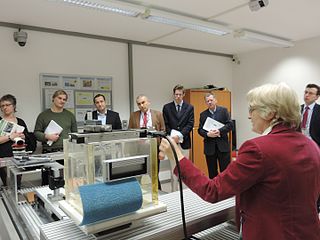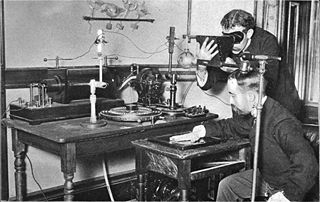
The sievert is a unit in the International System of Units (SI) intended to represent the stochastic health risk of ionizing radiation, which is defined as the probability of causing radiation-induced cancer and genetic damage. The sievert is important in dosimetry and radiation protection. It is named after Rolf Maximilian Sievert, a Swedish medical physicist renowned for work on radiation dose measurement and research into the biological effects of radiation.
Ionizing radiation, including nuclear radiation, consists of subatomic particles or electromagnetic waves that have sufficient energy to ionize atoms or molecules by detaching electrons from them. Some particles can travel up to 99% of the speed of light, and the electromagnetic waves are on the high-energy portion of the electromagnetic spectrum.
Medical physics deals with the application of the concepts and methods of physics to the prevention, diagnosis and treatment of human diseases with a specific goal of improving human health and well-being. Since 2008, medical physics has been included as a health profession according to International Standard Classification of Occupation of the International Labour Organization.

Radiation dosimetry in the fields of health physics and radiation protection is the measurement, calculation and assessment of the ionizing radiation dose absorbed by an object, usually the human body. This applies both internally, due to ingested or inhaled radioactive substances, or externally due to irradiation by sources of radiation.
Radiation protection, also known as radiological protection, is defined by the International Atomic Energy Agency (IAEA) as "The protection of people from harmful effects of exposure to ionizing radiation, and the means for achieving this". Exposure can be from a source of radiation external to the human body or due to internal irradiation caused by the ingestion of radioactive contamination.
Equivalent dose is a dose quantity H representing the stochastic health effects of low levels of ionizing radiation on the human body which represents the probability of radiation-induced cancer and genetic damage. It is derived from the physical quantity absorbed dose, but also takes into account the biological effectiveness of the radiation, which is dependent on the radiation type and energy. In the SI system of units, the unit of measure is the sievert (Sv).

Health physics, also referred to as the science of radiation protection, is the profession devoted to protecting people and their environment from potential radiation hazards, while making it possible to enjoy the beneficial uses of radiation. Health physicists normally require a four-year bachelor’s degree and qualifying experience that demonstrates a professional knowledge of the theory and application of radiation protection principles and closely related sciences. Health physicists principally work at facilities where radionuclides or other sources of ionizing radiation are used or produced; these include research, industry, education, medical facilities, nuclear power, military, environmental protection, enforcement of government regulations, and decontamination and decommissioning—the combination of education and experience for health physicists depends on the specific field in which the health physicist is engaged.

Radioactive contamination, also called radiological pollution, is the deposition of, or presence of radioactive substances on surfaces or within solids, liquids, or gases, where their presence is unintended or undesirable.

The linear no-threshold model (LNT) is a dose-response model used in radiation protection to estimate stochastic health effects such as radiation-induced cancer, genetic mutations and teratogenic effects on the human body due to exposure to ionizing radiation. The model assumes a linear relationship between dose and health effects, even for very low doses where biological effects are more difficult to observe. The LNT model implies that all exposure to ionizing radiation is harmful, regardless of how low the dose is, and that the effect is cumulative over lifetime.

A hot particle is a microscopic piece of radioactive material that can become lodged in living tissue and deliver a concentrated dose of radiation to a small area. A generally accepted theory proposes that hot particles within the body are vastly more dangerous than external emitters delivering the same dose of radiation in a diffused manner. Other researchers claim that there is little or no difference in risk between internal and external emitters, maintaining that individuals will likely continue to accumulate radiation dose from internal sources even after being removed from the original hazard and properly decontaminated, regardless of the relative danger from an internally sourced radiation dose compared to an equivalent externally sourced radiation dose.
The Health Protection Agency (HPA) was a non-departmental public body in England. It was set up by the UK government in 2003 to protect the public from threats to their health from infectious diseases and environmental hazards.
The International Commission on Radiological Protection (ICRP) is an independent, international, non-governmental organization, with the mission to protect people, animals, and the environment from the harmful effects of ionising radiation. Its recommendations form the basis of radiological protection policy, regulations, guidelines and practice worldwide.
Radiobiology is a field of clinical and basic medical sciences that involves the study of the effects of ionizing radiation on living things, in particular health effects of radiation. Ionizing radiation is generally harmful and potentially lethal to living things but can have health benefits in radiation therapy for the treatment of cancer and thyrotoxicosis. Its most common impact is the induction of cancer with a latent period of years or decades after exposure. High doses can cause visually dramatic radiation burns, and/or rapid fatality through acute radiation syndrome. Controlled doses are used for medical imaging and radiotherapy.
Bioenvironmental Engineers (BEEs) within the United States Air Force (USAF) blend the understanding of fundamental engineering principles with a broad preventive medicine mission to identify, evaluate and recommend controls for hazards that could harm USAF Airmen, employees, and their families. The information from these evaluations help BEEs design control measures and make recommendations that prevent illness and injury across multiple specialty areas, to include: Occupational Health, Environmental Health, Radiation Safety, and Emergency Response. BEEs are provided both initial and advanced instruction at the United States Air Force School of Aerospace Medicine at Wright-Patterson Air Force Base in Dayton, Ohio.
David A. Schauer, ScD, CHP, is executive director emeritus of the National Council on Radiation Protection and Measurements (NCRP). During his tenure a number of updated and new publications were issued by the Council.
The committed dose in radiological protection is a measure of the stochastic health risk due to an intake of radioactive material into the human body. Stochastic in this context is defined as the probability of cancer induction and genetic damage, due to low levels of radiation. The SI unit of measure is the sievert.

The Philippine Nuclear Research Institute (PNRI) is a government agency under the Department of Science and Technology mandated to undertake research and development activities in the peaceful uses of nuclear energy, institute regulations on the said uses, and carry out the enforcement of said regulations to protect the health and safety of radiation workers and the general public.
The Centre for Radiation, Chemical and Environmental Hazards (CRCE) is a British government environmental research site, run by Public Health England (PHE) in Chilton, Oxfordshire that monitors levels of toxic chemicals and background radiation in the British environment; it is largely a continuation of the former National Radiological Protection Board (NRPB).

Flight-time equivalent dose (FED) is an informal unit of measurement of ionizing radiation exposure. Expressed in units of flight-time, one unit of flight-time is approximately equivalent to the radiological dose received during the same unit of time spent in an airliner at cruising altitude. FED is intended as a general educational unit to enable a better understanding of radiological dose by converting dose typically presented in sieverts into units of time. FED is only meant as an educational exercise and is not a formally adopted dose measurement.

The history of radiation protection begins at the turn of the 19th and 20th centuries with the realization that ionizing radiation from natural and artificial sources can have harmful effects on living organisms. As a result, the study of radiation damage also became a part of this history.








